Riding the crosscut…
September 23, 2012
I built a crosscut sled to improve on the not so accurate miter fence of my table saw for repeated 90 degree cuts. The original aspiration was to build The Super Sled. Given that I had only block-board, a small piece of melamine finish plywood and no motivation (money) to go buy some clean new pieces of ply, the plan was scaled down to try and first achieve a simpler design and make it even simpler if possible.
This is the final result…
The runners are from a length of Sal I have, the fence is three laminated pieces of 3/4 in plywood with melamine finish and the back support is a thick leftover piece of Beech from when I made a pair of speaker stands.
Performing an accuracy check on the squareness using the 5-cut method gave me an error of about 0.3 mm for a linear 100 cm for the left side of the fence and an error of 2.2 mm for a linear 100 cm for the right side. The difference is because there is a slight warp in the melamine plywood towards the very right edge. I can live with the error as long as i remember not to make cuts longer than 25cm (error of 0.55 mm) using the right side of the fence. I will graduate to a better sled soon but this will do for the time being.
Eager to put the crosscut sled to the test I decided to humor the wife with a simple small shoe rack to fit cozily in corner space behind the main door. I used a piece of recovered block-board shelving to cut equal width wood strips with varying lengths and screw/glue them together.
Here is the SketchUp model and this is what it looks like…
Since this is going to be for rough use and I did not have my sander handy for the time being I have just left it as is, burn marks and all. Now it sits in the corner just barely large enough to hold the shoes and slippers…
Ramping up…
September 11, 2012
I built a table-saw stand with casters making it easy to move around. Since I work outside in the front parking + garden area I built a ramp to be able to roll it all the way outside without requiring any lifting of the saw. Later I plan to build a tool trolley and router table on casters as well.
I assembled the ramp using the same slotted angles I used for storage racks. The floor boards I cut out of two 6 ft doors.
- The basic skeleton for the ramp
- The ramp floor is composed of three separate pieces. Lowermost in place.
- The boards all have a cleat on the back to hook into the skeleton cross supports
- The topmost board attached. Houston the ramp is operational
- I wonder if the ramp can do double duty as a slide if there are small kids around.
The top and the bottom boards have an additional quarter piece attached to them via hinges. This gives them some freedom of movement while resting on the floor to compensate for the flexing that occurs when weight passes over the ramp.
Let the good times roll…
September 10, 2012
I don’t have a permanent workshop setup, however between my study, the front parking + garden area and the rear utility space, there is more than enough space for me to work.
But not having a permanent setup means having to setup, work, clean and restore everything every single time. Every time I want to work with the table-saw (which is almost always) I have to first carry my workbench out front and then carry the table-saw and put it on top of the workbench. There are multiple problems with this process. It is time consuming and tiring for one, I lose the use of my workbench and most importantly if I keep it up then I am probably going to throw out my back one of these days. Solution: make a mobile table-saw stand and a ramp over the front steps to roll it out and back in without ever having to lift it.
Here is my table-saw stand in all its blue glory.
It took over 3 weekends and several weekday evenings to complete. I spent a lot of time trying to figure out how to build one using just the block-board I reclaimed from my friend who did a interior makeover and threw out all the existing wood.
Block-board is good when used as large flat pieces to make things like doors, tops, shelves, etc. Its structural strength is limited, traditional joints cannot be done with any measure of reliability, it needs to be glued and screwed/nailed together, one needs to be careful when putting screws into it since there are gaps in the softwood cores sandwiched between two thin plywood sheets and only screws into the face will hold well with some degree of reliability. Additionally the stuff I had recovered was cracked & warped and full of nails.
So it was quite a task cleaning up the nails, cutting away the bad portions and then using what was left in a manner that would be strong(ish) for the purpose of holding the table-saw
As part of building this stand I learned/experimented with the following:
- Using SketchUp for modeling
- Ripping large panels of wood single-hand and without the aid of the rip fence
- Repeated cross and miter cuts using the miter fence
- Bevel cuts by tilting the table saw blade
- Sanding, priming, painting
- Epoxy filling to make repairs
The stand is made up of 44 individual pieces not including the casters. Here is the model file – TableSawStand.skp (the actual saw-stand is hidden, to view it unhide it in the outliner)
With the stand ready I then built the ramp so that it can be rolled in and out of the front door, but that is a story for another post.
Making more space…
September 10, 2012
With more space comes more clutter…
I managed for a short while after doing my first round of very rudimentary organization (Making space)
Then good fortune shined when a friend decided to completely redo his home interiors. His interior designer categorically ripped up and discarded nearly all existing furnishings. The good soul offered the chance to come and reclaim anything that might be of use. Two trips and I now have a whole bunch of old wooden doors and kitchen cabinet doors and plywood backing and cabinet shelves and cupboard drawers… a lot of used wood.
Since a lot of it was quite literally ripped out and not dismantled there are many pieces with torn out edges, long cracks running across, twists & sags and nails & screws & handles & hinges. Also almost all of it is average quality blockboard. But I am drifting… the fact is that all this stuff was finally dumped in my room taking up entire corners and the entire floor space in my room. End result back to square -1.
I became very good at tiptoeing over stuff and my maid refused to grace my room with her all powerful broomstick. I kept putting a second round of organization off until I completed my table saw stand which took so long since I was treating it as an experimental project for trying out new stuff.
Finally with the table saw stand done I decided to get down to cleaning up. So I went to S P Road and picked up a bunch of slotted angles to make relatively inexpensive and strong racks. Overall dimensions: H x L x D – 7 ft x 4 ft x 2 ft, with 5 shelves
This is the final result…
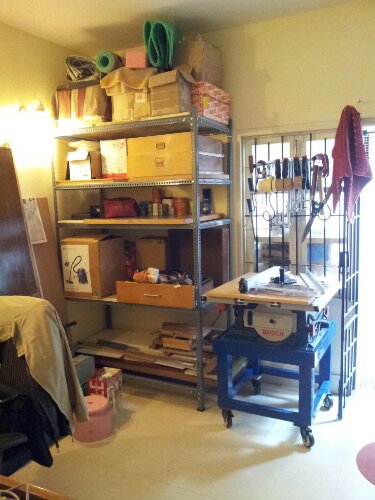
The before can be visualized by taking all the vertically piled stuff and putting it all on the ground in the entire floor space shown in the photograph. The shelves are actually the cabinet doors recovered from my friends place lying across the slotted angle skeleton. You can see the table saw stand I made standing on the right.
I was happy with the result and the strength of the final structure. So I went ahead and got more of this stuff to make storage space in my small front entrance parking space. That is where I store the long doors and small wood scrap and stuff.
A photo of the outside storage shelves. Overall dimensions: H x L X D – 3 ft x 7 ft x 2 ft
SAW Part 1
July 13, 2012
The initial forays into wood work has made one thing absolutely crystal clear… i will sooner than later have to start cutting straight and square to be able to do any of the stuff i am dreaming of building someday.
Another thing made crystal clear is that now that i am back to corporate drone duty spending half my weekend planing to get square corners is not really a viable option anymore. On the flip side going back to my earning ways I can scrape enough to spend on what I need to bridge the gap.
So after struggling with an unreliable and almost unmentionable attempt at a diy table saw using my existing circular saw I finally decided to do the leg work required for a table saw. Thus began the great search for a small portable table saw in Bangalore. The search yielded a net result of 2 models -Makita MLT100 and Bosch GTS 10 out of a list of 2 available models (yeah, that’s all unless you want to import it blind based on reviews and photos with non-existent after sales support and warranty).
Checked out the Makita MLT 100 at the local distributor who was very helpful as far as showing the saw is concerned. As expected from the reviews it has a really crappy fence so Bosch it was going to be. However, I was absolutely adamant on being in the physical vicinity of the GTS 10 before ordering it.
Sri Varu Power Tools got us in touch with the right persons at Bosch which resulted in a visit to their spanking new power-tool training center in Adugodi (very cool!) and got to see, touch, feel and operate a GTS 10 (Awesome!!). Two weeks later I have a brand new Bosch 10 GTS (Freakkin’ Awesome!!)
And now some photos of the unpacking…
Big blue box
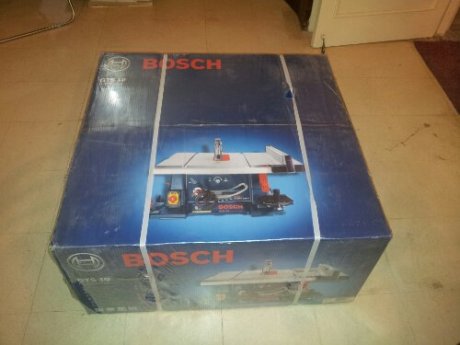
Out of the box and onto the table
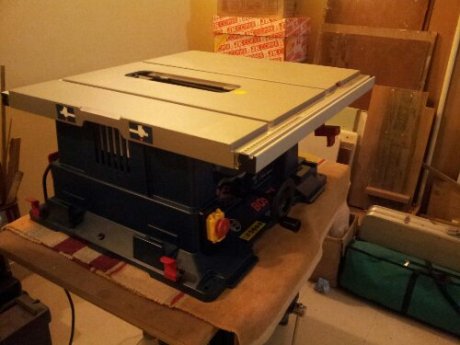
Fences and other accessories
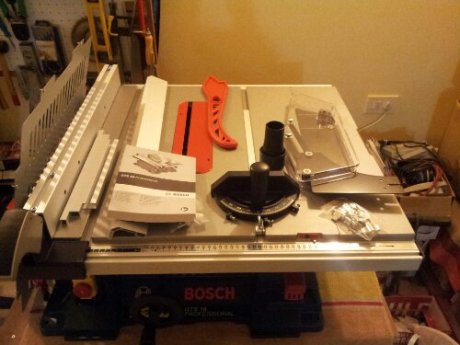
The blade height adjustment wheel refused to budge initially and i got worried. Turns out there is a big thermocol square wedged behind to keep the motor from moving during transport

Error in the main rip fence. On locking it down the fence kept twisting out of true by a couple of degrees. See the difference in the gap between the blade and the fence on the left and right edges of the blade.
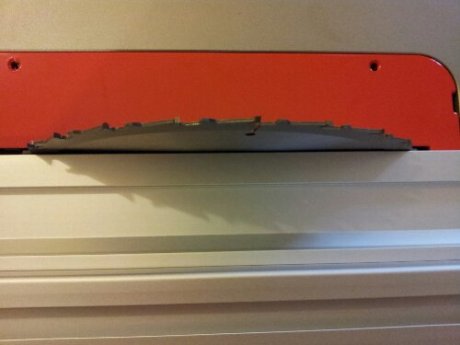
Needless to say that I was majorly disappointed. It turned out to be a small assembly error that I fixed later by dismantling the rip fence and reassembling it properly.
I have had this post sitting in drafts for more than 2 months… ever since I got this wonderful tool i have been ripping it(wood) up One of the completed projects is a stand with casters for the table saw that i will detail in future posts.
Workbench Bootstrap: Pluggin the Holes
January 30, 2012
Dogholes and improvised benchdogs…
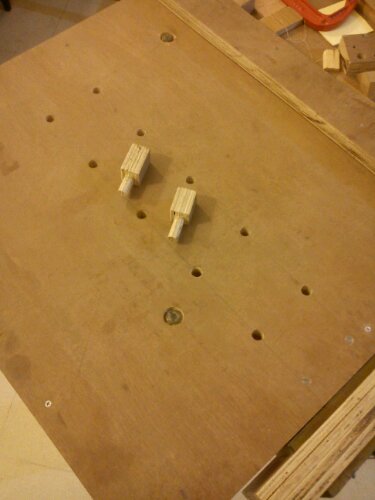
Benchdog Sr. and Benchdog Jr.
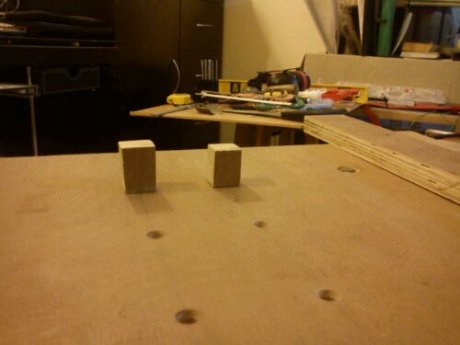
Now that I have managed to complete my first functional and portable workbench… its time to get cracking on the planned projects.
Workbench Bootstrap: Jaw Liners Installed
January 29, 2012
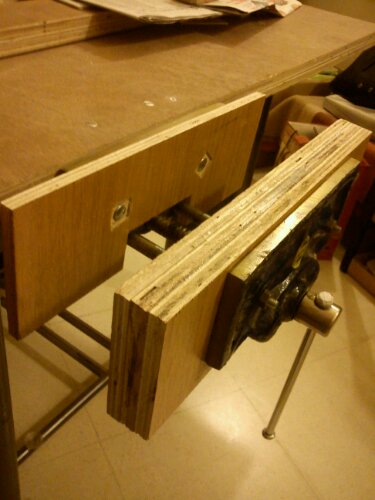
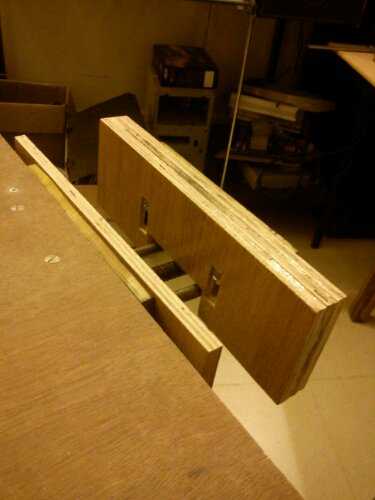
Jugaad: Cardboard box + Visiting card box = Screw organizer
January 15, 2012


In the safety and comfort of your car
February 7, 2011
A basic underlying idea of having a car for personal transport is that it provides a safe and comfortable space that protects the traveler from the outside environment and a personal space that cannot easily be intruded upon by others. This basic feature is exemplified by various car adverts focusing on private comfort, luxury, safety, space etc…
Why then, I wonder, I felt pretty much boxed in the other day I was commuting to work in my car. Agreed it was a typical day with other commuter vehicles around me but I was snug in my car and inching my personal space through the traffic. For some reason I couldn’t feel, for lack of better words, ‘my space’.
Hmm… I closed the car windows, switched on the air conditioning, re-adjusted my seat and popped in a music CD to shut out the ever excited RJ’s shouting out my speakers.
I was just starting to relax when the car in front jumped forward giving me some space to move ahead. Practiced reflexes released the brakes to press the accelerator and the clutch was relaxed in smooth harmony, but the gracefulness of the moment was broken, I had to abort and slam the brakes as the person on my right tried to inch their private space in the same empty space ahead and managed to angle it in just enough to prevent my straight line motion.
Quickly moving into 2D space and with minor corrections on my power-steering and short accelerated bursts I angled myself to inch ahead and block the intended lane change. In my mind I was the spacewalking NASA astronaut maneuvering with utmost precision to fix a problem. But instead of NASA ground control congratulating me I was greeted with loud and insistent honking from the commuter on my left. Irritated I thought, “Relax man, I am just protecting my space from this #$%^head”. From then on until the signal turned I was ready like the crouching tiger and as soon as it was green I leapt and reclaimed what was mine. “Hah!!, take that you $@#$@#$”.
Five minutes later it happened again and then once more near my office and a last time when approaching the car park. I finally relaxed on my desk triumphant at having defended my space successfully 3 times out of 5, better than the average so far this week.
Being a stickler to detail and acquired compulsive hair splitting I realized there was a slight difference – I was defending ‘my vehicle space’ since ‘my space’ was always with me inside the car. But then ‘my vehicle space’ was almost as important or even more so than ‘my space’ since I did not feel comfortable when it was intruded upon, it felt so personal.
So to put it more accurately
‘my space’ (while driving) = ‘my personal space’ + ‘my vehicle space’
Feeling very scientific here are the corollaries I extracted:
– a bigger vehicle increases both personal space and vehicle space. For e.g. driving an SUV on Commercial Street (a very busy one-way street in Bangalore, India) will extend your space right into the shops on both sides and overlap the space occupied by the vehicles in the front and back.
– in personal vehicles ‘my space’ is directly proportional to vehicle size and indirectly proportional to the vehicles around. So a 4WD SUV next to a compact hatchback is akin to a horse next to a rabbit, but next to a multi-axle bus its a horse next to an elephant.
What are your inferences?
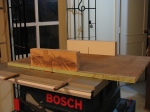

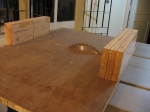








![IMG_4087[1]](https://lemonynirvana.wordpress.com/wp-content/uploads/2012/09/img_40871.jpg?w=614&h=461)